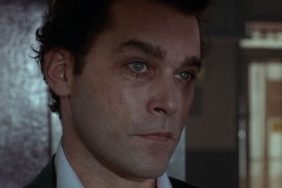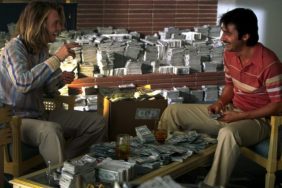
Cinema has always had a problem with visual effects. When writing a novel or even composing a painting, the only limit is your imagination. But when you have to tell a story with out of this world imagery, locations or characters and actually put them on camera, the juxtaposition of reality and fakery can have disastrous consequences. Bad visual effects can take an audience right out of a movie, never to return, and indeed the history of cinema is at least partially a history of achieving greater realism through technology. From silent to sound, from black and white to color, from lizards with spikes glued to their backs to expensive computer generated images of the dinosaurs of Jurassic World.
But when visual effects do their job right, the experience can be transcendent. So, we asked ourselves, what is The Best Visual Effects Movie Ever? Then we asked our film critics William Bibbiani, Witney Seibold and Brian Formo to answer that question for us, because damn it, that’s their job.
Find out what films they picked, and come back next week for another highly debatable installment of CraveOnline’s The Best Movie Ever!
Check Out: The Best Movie Ever: Musicians
Witney Seibold’s Pick: A Trip to the Moon (1902)

Hm. Do I choose the best film that has convincing special effects in it? Do I choose the film that may not be of the highest quality, but has excellent special effects (yes, there are plenty)? Do I choose a film with special effects so excellent that I don’t notice them? Or do I choose a film that has unrealistic special effects, but are incredibly striking and memorable as a result?
Thanks to moderns CGI, any film with a large enough budget now has the ability to create just about any adventurous visuals they want. We’ve seen superheroes flying, cities crumbling, planets exploding, starships fighting, and, for the first time in cinema history, audiences aren’t dazzled. At least not the way they used to be. There is no longer the same sort of wonder or awe as to how a shot was achieved; there is no longer the thrill of seeing something truly new and unique in a movie through a new type of special effects. Now we all assume it’s achieved via CGI, and we leave it there. Occasionally a CGI creation will break through (Avatar, Life of Pi, Dawn of the Planet of the Apes), but for the most part, we audiences simply absorb without any wonderment invading through our eyeballs.
As such, I must regress. Past the CGI marvels of the modern age. Before the convincing environs of Master and Commander: The Far Side of the World. Back past Titanic. Back past Jurassic Park and Terminator 2. Back past The Phantom Menace and even the original Star Wars. Back past An American Werewolf in London and John Carpenter’s The Thing. Skipping over bizarre experimental flicks like Eraserhead. Looking painfully past Ray Harryhausen and 2001: A Space Odyssey (still, easily, one of the best films ever made). Speeding past King Kong. I fly past all these solid candidates, and I land to where wonderment began way back in 1902. I select Georges Méliès’ classic sci-fi short A Trip to the Moon.
All serious film students have seen this film, or still need to. Méliès practically invented the notion of special effects. Using bizarre sets and costumes, and pairing them with clever editing and forced perspective, Méliès made a long string of utterly enchanting – and totally bizarre – Hieronymus Bosch-like dreamscapes, all when film was just in its relative infancy. Not only are the visuals still amazing over a century later, but one can feel the enthused innovation of excited filmmakers in every frame. Avatar is all well and good, but A Trip to the Moon is, to this day, infinitely more exciting to watch than most modern blockbusters.
Check Out: The Best Movie Ever: Cameron Crowe
Brian Formo’s Pick: 2001: A Space Odyssey (1968)

“Fix it in post,” is something often said on movie sets. Essentially, it’s a request to not slow down production because there was a human error in a shot that can easily be fixed in post-production by someone at a computer. Every shot takes a long time to set up. If it can be fixed later, fix it later. Now, thanks to CGI being able to create entire worlds, almost every big movie feels like it was made entirely in post-production. These worlds do look exactly like the name implies, however—like a computer generated image. And the more CGI that is used, the less threatening that fabulous beasts, monsters, and space itself has become because no one on set is engaging with them, including the actors. All the terror, and ohhs and ahhs will be added in post.
No, movies aren’t real, but practical effects can make them feel real because it involves real things happening on set or in a model. And when live effects happen on set, visual effects—though it has its own team—overlaps directly with multiple creative crews: production design, camera, etc. in order to make it work. This can make an entire film set engage with a certain level of collective cleverness that can actually push their mediums forward and make the audience wonder how’d they do that? With CGI—not to do a disservice to those in the field, as it takes 1000s of hours to make these worlds—we don’t necessarily wonder how they did it. We just assume it was done on a computer. In post-production.
Perhaps the most fascinating “how’d they do that?” is one of the earliest and most elaborate space exploration films—and one of the greatest films of all time—Stanley Kubrick’s 2001: A Space Odyssey. Kubrick’s film (and visual effects team) put such an emphasis on how to make the stars that Kubrick couldn’t employ acting stars—because each shot took so much time to complete. Forget post-production. This set had separate work-flows that were labeled such sexy things as “The Sausage Factory” and “The Brain Room”. And when Kubrick needed to fake zero gravity (for the beautiful long-take that follows an astronaut running on a spaceship in a complete vertical circle), they built the world’s largest (and most detailed) hamster wheel.
The 2001 “Sausage Factory” was tasked with gathering all the separate photograph plates that had been shot with a half-dozen cameras (sometimes in 24 hour shifts) of small chemical explosions—within a box the size of a cigarette—that would become galaxies and exploding stars, and rear project them on sets and models to get the images on the same negative. Some negatives, such as the men on the moon who discover a foreign object, were not exposed for over a year until all the extra components were shot and could be overlaid onto one film print. That’s because throughout the film, stars, little holes in boards, were the hardest to maintain. Certain sizes and motor speeds looked best for 35mm cameras but would look fake at 70mm, so different star sizes and speeds were repeatedly made specific for each set and model. But even if it took a few years to get all of these elements on the same film print, all of these elements did occur on a set and were captured. Kubrick and his crew were able to control light in such a way as to make the impossible look possible (for instance, a floating pen was just a pen taped to glass, lit in such a way as to make the glass invisible and the pen appear to float) and make us still ask today, in the age of CGI, “how’d they do that?“.
As for the story? Well, the monolith that appears in three separate instances—at the dawn of man, on the moon, and in a distant galaxy—is perhaps the greatest MacGuffin in film history. What does it symbolize? Perhaps its something as simple as what we all wonder when we look up at the stars or think about early existence: It’s what does it all mean? in physical form. From birth to death we litter space with that single question, no matter how evolved we become.
Check Out: The Best Movie Ever: Horror Remakes
William Bibbiani’s Pick: Life of Pi (2012)

I’m torn about this category, because some of the most impressive visual effects I have ever seen weren’t necessarily from the best movies. Dawn of the Planet of the Apes has arguably the most beautiful and realistic motion capture effects ever filmed, but the movie is just a fun pulpy potboiler about an ape revolution. Speed Racer has some of the trippiest imagery I’ve ever seen, but it’s a dumb little movie that refers to ineffective ninjas as “nonjas.”
And while yes, I’ll still marvel at the wonders of 2001: A Space Odyssey, Jurassic Park and even my beloved Starship Troopers, I am perhaps forced to admit that the most impressive visual effects I’ve ever seen – as in, those that made an indelible impression, whether or not they are realistic – stems from Ang Lee’s 2012 religious parable Life of Pi. The simple story of a boy stuck on a lifeboat with a man-eating tiger would have a decent set-up for a brutal potboiler, but Lee’s film – based on the novel by Yann Martel – has loftier ambitions. It claims, right at the beginning of the story, that “will make [you] believe in God.” If that doesn’t set an audience’s expectations high, I can’t entirely imagine what would.
Life of Pi doesn’t make me believe in God. (In fact, I would argue that the film ultimately provides a fantastic counterargument against Him. But that’s another topic.) But Ang Lee does offer absolutely heavenly imagery to make his point, and to drive the film’s title hero, played by Suraj Sharma, towards the outer regions of epiphany. Life of Pi uses CGI not to stand in for reality, but to expand it to new and beautiful heights, transforming the ocean into a glowing pool of behemoths and the sky into an abstract image of love. Unlike many of the best visual effects movies, Lee’s film does not attempt to trick you into thinking what you’re watching is “real,” it tries to hypnotize you into wishing it was. It begs you to choose to believe in gorgeous symbolism over conventional logic, and it takes the breath away every time it tries.
Whether or not Life of Pi achieves its lofty ambition is a matter of some debate, but your mouth goes slack either way. These visual effects will stun you in a way that few ever have, and possibly – just possibly – make you see God (whether or not God’s really there.)






